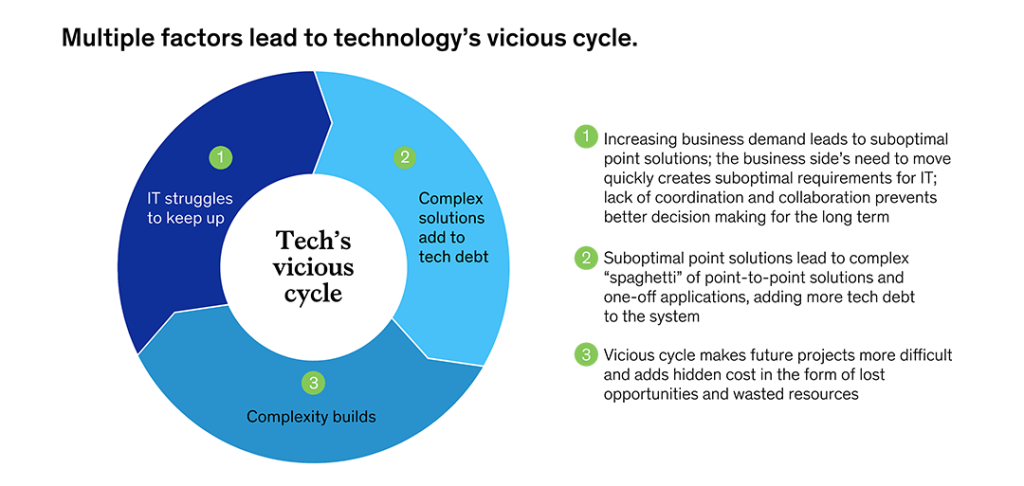Technology has become synonymous with business. Many companies are adopting new tech innovations to sustain growth. This growth is leading to the introduction of new-age tools and solutions. However, this widespread tech adoption also leads to the inevitable challenge of technical debt in the business ecosystem.

Technical debt is a common issue that affects many businesses and is often lurking beneath the surface until it becomes too big to ignore. Like financial debt, it can accumulate over time and hinder growth, productivity and innovation. In this article, we will explore the concept of technical debt and provide actionable strategies to reduce it effectively.
Understanding Technical Debt
Technical debt can encompass everything from applications to  physical hardware. The term refers to the inefficiencies and waste that arise when IT resources no longer meet a company’s needs. As infrastructure ages and new capabilities get built atop legacy frameworks, business are pressured to divert budgets and resources from innovation to servicing technical debt.
physical hardware. The term refers to the inefficiencies and waste that arise when IT resources no longer meet a company’s needs. As infrastructure ages and new capabilities get built atop legacy frameworks, business are pressured to divert budgets and resources from innovation to servicing technical debt.
It occurs as a result of choosing quick, short term and inexpensive technology solutions over robust and efficient ones. These off-the-balance sheet costs accrue over time and can have serious consequences that lead to increased maintenance costs and reduced ability to adapt to changing market conditions.

Source: McKinsey
Types of Technical Debt
Each type of technical debt presents unique challenges and requires specific strategies for management and resolution. Recognizing and addressing these various forms of debt is essential for maintaining a healthy and sustainable IT ecosystem within businesses.
Code Debt: This is the most common form, resulting from poor coding practices, lack of standardization, inadequate comments, and outdated techniques. It hinders maintenance and scalability.
Architectural Debt: Involves using outdated technologies, creating overly complex structures, or neglecting scalability concerns. It can be particularly costly as it often requires significant refactoring or a complete system redesign.
Infrastructure Debt: Your digital environment has many hardware components, and if they’re not kept up to date, system errors, downtime, maintenance and repairs, and even safety hazards can result.
Documentation Debt: Involves insufficient or outdated documentation. This makes it difficult for both new and existing team members to understand the system and the rationale behind certain decisions, impacting efficiency in maintenance and development.
There are a host of reasons why tech debt piles up:
- Inadequate planning or design, which can result in suboptimal system architecture
- Limited resources, including budget constraints, time pressure or lack of skilled personnel that leads to cutting corners
- Focusing on immediate business goals at the expense of long-term stability and scalability
- Incomplete or outdated documentation that makes it challenging to understand and maintain a system
- Insufficient testing, resulting in undiscovered issues that accumulate as technical debt
- Legacy systems that require more maintenance or are difficult to integrate with newer technology
- Rapidly changing technology that makes it difficult to keep up with the latest trends and innovations
Managing Technical Debt
Managing technical debt is an ongoing effort that requires  collaboration, discipline, and a systematic approach. By setting up a structured process and continuously building on it, businesses can ensure that technical debt is kept in check, allowing them to innovate and grow without being held back by legacy issues. Here are some effective strategies deal with technical debt:
collaboration, discipline, and a systematic approach. By setting up a structured process and continuously building on it, businesses can ensure that technical debt is kept in check, allowing them to innovate and grow without being held back by legacy issues. Here are some effective strategies deal with technical debt:
Identify and Prioritize
Start by conducting a technical debt audit to uncover where shortcuts have been made. Rank the most critical issues and create a register to track progress.
Integrate Debt Management into Workflow
Don’t leave technical debt for later. Incorporate it into your regular workflow by allocating time for fixes and reviewing during agile sprints.
Educate Your Team
Make sure your team understands technical debt and its impact. Train them to avoid shortcuts and encourage knowledge sharing to foster a long-term mindset.
Improve Documentation
Keeping detailed documentation makes it easier to identify, understand, and fix technical debt. Regular updates and standardized templates are key.
Update and Refactor Regularly
Rather than making large, risky overhauls, focus on incremental improvements. Regular updates help keep systems running smoothly without accumulating debt.
Optimize Security Practices
Strong security measures reduce vulnerabilities that can contribute to technical debt. Automating security monitoring can also help minimize risk.
Manage Dependencies
Stay on top of system dependencies by updating them regularly and using tools that automate the process to ensure compatibility and security.
Foster Continuous Improvement
Encourage your team to continuously learn and celebrate efforts to reduce technical debt. This mindset helps prevent new debt from forming and ensures steady progress.
Create a Tech-Forward Culture
Technical debt is an inevitable byproduct of technological advancement within  businesses. However, when recognized and managed proactively, it can be controlled and minimized. It’s important to manage this debt with a comprehensive strategy that includes development roadmaps. In practice, a business’s collective efforts to manage technical debt will help to encounter less debt in the future.
businesses. However, when recognized and managed proactively, it can be controlled and minimized. It’s important to manage this debt with a comprehensive strategy that includes development roadmaps. In practice, a business’s collective efforts to manage technical debt will help to encounter less debt in the future.
Ultimately, understanding and addressing technical debt is not just about maintaining systems – it’s about preserving the company’s capacity for innovation, and long-term success in an ever-evolving technological landscape. By fostering a culture of continuous improvement, prioritizing quality, and investing in regular maintenance, businesses can mitigate the risks. The net benefit is becoming a tech-forward company where technology is an engine for continual growth and productivity.
Work with a Strategic Tech Partner
A strategic partner like PointSolve can assess and understand your  current environments, priorities, and business goals to effectively manage technical debt and optimize IT investments. We are here to help you develop strategies tailored to your business’s needs. Contact us today to learn how we can provide support and optimize your IT infrastructure for future growth and success.
current environments, priorities, and business goals to effectively manage technical debt and optimize IT investments. We are here to help you develop strategies tailored to your business’s needs. Contact us today to learn how we can provide support and optimize your IT infrastructure for future growth and success.

